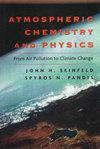Constraining the budget of atmospheric carbonyl sulfide using a 3-D chemical transport model
IF 5.2
1区 地球科学
Q1 ENVIRONMENTAL SCIENCES
引用次数: 0
Abstract
Abstract. Carbonyl sulfide (OCS) has emerged as a valuable proxy for photosynthetic uptake of carbon dioxide (CO2) and is known to be important in the formation of aerosols in the stratosphere. However, uncertainties in the global OCS budget remain large. This is mainly due to the following three flux terms: vegetation uptake, soil uptake and oceanic emissions. Bottom-up estimates do not yield a closed budget, which is thought to be due to tropical emissions of OCS that are not accounted for. Here we present a simulation of atmospheric OCS over the period 2004–2018 using the TOMCAT 3-D chemical transport model that is aimed at better constraining some terms in the OCS budget. Vegetative uptake of OCS is estimated by scaling gross primary productivity (GPP) output from the Joint UK Land Environment Simulator (JULES) using the leaf relative uptake (LRU) approach. The remaining surface budget terms are taken from available literature flux inventories and adequately scaled to bring the budget into balance. The model is compared with limb-sounding satellite observations made by the Atmospheric Chemistry Experiment – Fourier Transform Spectrometer (ACE-FTS) and surface flask measurements from 14 National Oceanic and Atmospheric Administration – Earth System Research Laboratory (NOAA-ESRL) sites worldwide. We find that calculating vegetative uptake using the LRU underestimates the surface seasonal cycle amplitude (SCA) in the Northern Hemisphere (NH) mid-latitudes and high latitudes by approximately 37 ppt (35 %). The inclusion of a large tropical source is able to balance the global budget, but further improvement to the SCA and phasing would likely require a flux inversion scheme. Compared to co-located ACE-FTS OCS profiles between 5 and 30 km, TOMCAT remains within 25 ppt (approximately 5 % of mean tropospheric concentration) of the measurements throughout the majority of this region and lies within the standard deviation of these measurements. This provides confidence in the representation of atmospheric loss and surface fluxes of OCS in the model. Atmospheric sinks account for 154 Gg S of the annual budget, which is 10 %–50 % larger than previous studies. Comparing the surface monthly anomalies from the NOAA-ESRL flask data to the model simulations shows a root-mean-square error range of 3.3–25.8 ppt. We estimate the total biosphere uptake to be 951 Gg S, which is in the range of recent inversion studies (893–1053 Gg S), but our terrestrial vegetation flux accounts for 629 Gg S of the annual budget, which is lower than other recent studies (657–756 Gg S). However, to close the budget, we compensate for this with a large annual oceanic emission term of 689 Gg S focused over the tropics, which is much larger than bottom-up estimates (285 Gg S). Hence, we agree with recent findings that missing OCS sources likely originate from the tropical region. This work shows that satellite OCS profiles offer a good constraint on atmospheric sinks of OCS through the troposphere and stratosphere and are therefore useful for helping to improve surface budget terms. This work also shows that the LRU approach is an adequate representation of the OCS vegetative uptake, but this method could be improved by various means, such as using a higher-resolution GPP product or plant-functional-type-dependent LRU. Future work will utilise TOMCAT in a formal inversion scheme to better quantify the OCS budget.用三维化学输运模型约束大气羰基硫化物的收支
摘要羰基硫化物(OCS)已成为光合作用吸收二氧化碳(CO2)的一种有价值的替代物,并且已知在平流层气溶胶的形成中起着重要作用。然而,全球OCS预算的不确定性仍然很大。这主要是由于以下三个通量项:植被吸收、土壤吸收和海洋排放。自下而上的估计并没有产生一个暴露的预算,这被认为是由于OCS的热带排放并没有被考虑在内。在这里,我们使用TOMCAT三维化学传输模型模拟了2004-2008年期间的大气OCS,旨在更好地约束OCS预算中的一些条款。OCS的营养吸收是通过使用叶片相对吸收(LRU)方法缩放英国陆地环境模拟器(JULES)的总初级生产力(GPP)输出来估计的。剩余的表面预算条款取自可用的温度通量库存,并进行适当的缩放以使预算达到平衡。该模型与大气化学实验-傅立叶变换光谱仪(ACE-FTS)的翼探测卫星观测结果以及美国国家海洋和大气管理局-地球系统研究实验室(NOAA-ESRL)在全球14个地点的表面烧瓶测量结果进行了比较。我们发现,使用LRU计算营养吸收低估了北半球(NH)中纬度和高纬度地区的地表季节性周期振幅(SCA)约37 ppt(35 %). 纳入一个大型热带源能够平衡全球预算,但SCA和分阶段的进一步改进可能需要通量反演方案。与位于5到30之间的同一位置的ACE-FTS OCS配置文件相比 公里,TOMCAT保持在25以内 ppt(约5 % 对流层平均浓度),并在这些测量的标准偏差内。这为模型中OCS的大气损失和表面通量的表示提供了信心。大气汇占154 Gg 年度预算的S,即10 %–50 % 比以前的研究更大。将NOAA-ESRL烧瓶数据中的地表月异常与模型模拟进行比较,结果显示均方根误差范围为3.3–25.8 ppt。估计生物圈总吸收量为951 Gg S、 在最近的反演研究范围内(893–1053 Gg S) ,但我们的陆地植被通量占629 Gg 年度预算的S,低于最近的其他研究(657–756 Gg S) 。然而,为了结束预算,我们用689的大型年度海洋排放期来弥补这一点 Gg S集中在热带地区,这比自下而上的估计要大得多(285 Gg S) 。因此,我们同意最近的研究结果,即丢失的OCS来源可能来自热带地区。这项工作表明,卫星OCS剖面为OCS通过对流层和平流层的大气层汇提供了良好的约束,因此有助于改善地表收支条件。这项工作还表明,LRU方法是OCS-植物吸收的充分代表,但该方法可以通过各种方式进行改进,例如使用更高分辨率的GPP产品或依赖于植物功能类型的LRU。未来的工作将在正式的反演方案中使用TOMCAT,以更好地量化OCS预算。
本文章由计算机程序翻译,如有差异,请以英文原文为准。
求助全文
约1分钟内获得全文
求助全文
来源期刊

Atmospheric Chemistry and Physics
地学-气象与大气科学
CiteScore
10.70
自引率
20.60%
发文量
702
审稿时长
6 months
期刊介绍:
Atmospheric Chemistry and Physics (ACP) is a not-for-profit international scientific journal dedicated to the publication and public discussion of high-quality studies investigating the Earth''s atmosphere and the underlying chemical and physical processes. It covers the altitude range from the land and ocean surface up to the turbopause, including the troposphere, stratosphere, and mesosphere.
The main subject areas comprise atmospheric modelling, field measurements, remote sensing, and laboratory studies of gases, aerosols, clouds and precipitation, isotopes, radiation, dynamics, biosphere interactions, and hydrosphere interactions. The journal scope is focused on studies with general implications for atmospheric science rather than investigations that are primarily of local or technical interest.
 求助内容:
求助内容: 应助结果提醒方式:
应助结果提醒方式:


